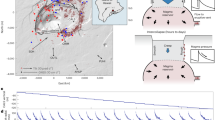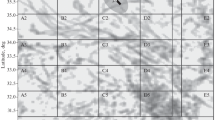Abstract
In this paper, the stress concentration process and the time-space distribution of stress when earthquakes are in preparation in one or more earthquake-generating bodies in a tectonic block have been analyzed and their relation with seismicity and earthquake precursors have been studied. The results show that: 1 When the regional stress field has intensified to a certain level, fracture begins in some block or blocks. The regional stress field will vary with time and the occurrence of strong earthquakes in groups is the result of the evolution of this dynamic stress field. In this process, the existence and development of more than one high stress concentration zone may give rise to a variety of pre-seismic anomaly-to-earthquake relations. 2 The process of stress variation in an earthquake-generating block generally appears as a nonlinear one. After the long-term elastic deformation, there may be more than one time of inelastic deformation and fault-softening from the beginning of the stage of inelastic deformation to just before the main fracture. Corresponding to such a nonlinearity, the stress and strain fields in the earthquake-generating block will display a complex pattern of time-space evolution; and thus the earthquake precursor fields controlled by stress and strain must display complexities in many aspects.
Similar content being viewed by others
References
Geng, L. M., Zhang, G. M. and Shi, Y. L., 1993. Preliminary research on the relations between field and source in earthquake preparation.Earthquake Research in China,9(4): 310–319 (in Chinese).
Mei, S. R., Hu, C. H. and Zhu, C. Z.et al., (eds.), 1982.The 1976Tangshan Earthquake, 251–256. Beijing: Seismological Press (in Chinese).
Mei, S. R., Liang, B. Y. and Zhu, Y. Q., 1989a. Digital simulation on precursory mechanism of the 1976 Tangshan earthquake.Earthquake Research in China,5(2): 27–34 (in Chinese).
Mei, S. R. and Liang, B. Y., 1989b. A mathematical simulation for seismogenic process of the Tangshan earthquake.Earthquake Research in China,5(3): 9–17 (in Chinese).
Sun, R. M. and Liu, F. T., 1995. Crust structure and strong earthquake in Beijing, Tianjin and Tangshan areas: I. P wave velocity structure.Acta Geophysica Sinica,38(5): 599–607 (in Chinese).
Zhang, G. M., Geng, L. M. and Shi, Y. L., 1993. A computer model for cyclic activities of strong earthquakes in continental seismic zones.Earthquake Research in China,9(1): 21–32 (in Chinese).
Zhang, Y. Z., 1981. On the anomalous crustal bulge and aseismic creep prior to the 1976 Tangshan earthquake.Acta Seismologica Sinica,3(1): 11–22 (in Chinese).
Zhang, Z. S., Xie, J. M. and Xu, F. Z.et al., 1981. Zhang, Z. S.et al., Vertical deformations associated with the 1976 TanghsanM=7.8 earthquake.Acta Geophysica Sinica,24(2): 182–191 (in Chinese).
Author information
Authors and Affiliations
About this article
Cite this article
Mei, SR. On the physical model of earthquake precursor fields and the mechanism of precursors′ time-space distribution (II) — How do the stress and strain fields evolve while a strong earthquake is in preparation and how does the evolution affect the seismicity and earthquake precursors?. Acta Seismologica Sinica 9, 1–12 (1996). https://doi.org/10.1007/BF02650618
Received:
Accepted:
Issue Date:
DOI: https://doi.org/10.1007/BF02650618




